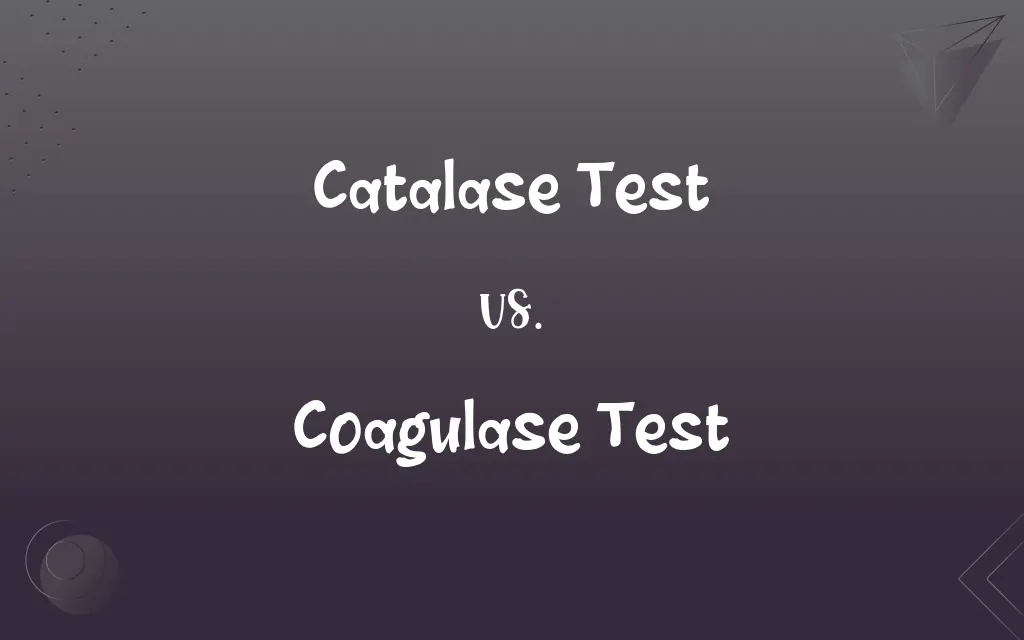Catalase Test vs. Coagulase Test: What's the Difference?
Edited by Aimie Carlson || By Janet White || Published on March 4, 2024
The catalase test differentiates bacteria based on catalase enzyme production, while the coagulase test identifies Staphylococcus aureus by its ability to coagulate plasma.

Key Differences
The catalase test is a biochemical assay used to identify bacteria that produce the enzyme catalase, which breaks down hydrogen peroxide into water and oxygen. The coagulase test, on the other hand, is used to differentiate Staphylococcus aureus, which produces the enzyme coagulase, from other staphylococci by its ability to coagulate plasma.
In the catalase test, a small amount of bacterial colony is mixed with hydrogen peroxide, and the production of bubbles indicates a positive result. The coagulase test involves mixing bacterial colonies with plasma, and the formation of a clot indicates a positive result.
The catalase test is used to distinguish between aerobic and facultatively anaerobic bacteria, as well as to differentiate among Gram-positive cocci. The coagulase test is specifically used to identify the pathogenic Staphylococcus aureus from other non-pathogenic staphylococci.
A positive catalase test is indicated by the rapid formation of bubbles, while a positive coagulase test is indicated by the formation of a clot within a few hours. Both tests are simple, rapid, and widely used in microbiology laboratories for bacterial identification.
The catalase test and coagulase test are important tools in clinical microbiology for the diagnosis of bacterial infections. While the catalase test is more general in nature, the coagulase test is highly specific for Staphylococcus aureus, a common cause of skin and wound infections.
ADVERTISEMENT
Comparison Chart
Purpose
Identifies bacteria producing catalase enzyme
Differentiates Staphylococcus aureus from other staphylococci
Principle
Breakdown of hydrogen peroxide into water and oxygen
Coagulation of plasma by the enzyme coagulase
Indicator
Formation of bubbles
Formation of a clot
Specificity
General test for aerobic and facultatively anaerobic bacteria
Specific for Staphylococcus aureus
Clinical significance
Used to distinguish between Gram-positive cocci
Used to identify pathogenic Staphylococcus aureus
ADVERTISEMENT
Catalase Test and Coagulase Test Definitions
Catalase Test
A diagnostic tool to differentiate between aerobic and anaerobic bacteria.
The absence of bubbles in the catalase test suggested anaerobic bacteria.
Coagulase Test
A biochemical assay to distinguish Staphylococcus aureus based on coagulase enzyme production.
The rapid clot formation in the coagulase test indicated a virulent strain of Staphylococcus aureus.
Catalase Test
A biochemical assay to identify bacteria producing catalase enzyme.
The catalase test was positive, indicating the presence of aerobic bacteria.
Coagulase Test
A test to differentiate pathogenic staphylococci from non-pathogenic species.
The absence of clot formation in the coagulase test indicated a non-pathogenic strain.
Catalase Test
A simple test using hydrogen peroxide to detect catalase enzyme activity.
The rapid formation of bubbles in the catalase test confirmed the bacterial strain's ability to produce catalase.
Coagulase Test
A test used in microbiology to identify bacteria that can coagulate blood plasma.
The coagulase test is crucial for diagnosing staphylococcal infections.
Catalase Test
A quick test for identifying bacteria capable of breaking down hydrogen peroxide.
The positive catalase test indicated the bacterium's potential for survival in oxygen-rich environments.
Coagulase Test
A method to detect the enzyme coagulase produced by certain bacteria.
The positive coagulase test suggested a potential risk of infection by the isolated bacterium.
Catalase Test
A method to distinguish between Gram-positive cocci based on enzyme production.
The catalase test helped differentiate Staphylococcus from Streptococcus species.
Coagulase Test
A diagnostic test to identify Staphylococcus aureus by its ability to coagulate plasma.
The coagulase test was positive, confirming the presence of Staphylococcus aureus.
FAQs
What does a positive catalase test indicate?
A positive catalase test indicates the presence of bacteria capable of producing the enzyme catalase.
What is the coagulase test?
The coagulase test is a diagnostic test used to differentiate Staphylococcus aureus from other staphylococci by its ability to coagulate plasma.
What is the catalase test?
The catalase test is a biochemical assay used to identify bacteria that produce the enzyme catalase.
What does a positive coagulase test indicate?
A positive coagulase test indicates the presence of Staphylococcus aureus.
Is the coagulase test specific for Staphylococcus aureus?
Yes, the coagulase test is highly specific for identifying Staphylococcus aureus.
How is the coagulase test performed?
The coagulase test is performed by mixing bacterial colonies with plasma, and the formation of a clot indicates a positive result.
What is the clinical significance of the catalase test?
The catalase test is used to distinguish between different types of bacteria, especially Gram-positive cocci, in clinical microbiology.
What are the limitations of the coagulase test?
The coagulase test may yield false-negative results for some strains of Staphylococcus aureus, and it does not differentiate between other species of staphylococci.
How is the catalase test performed?
The catalase test is performed by adding hydrogen peroxide to a bacterial colony, and the production of bubbles indicates a positive result.
Can the catalase test be used to identify anaerobic bacteria?
The catalase test is generally used to identify aerobic bacteria, but it can also be used to differentiate between aerobic and facultatively anaerobic bacteria.
Can the coagulase test be used for other purposes besides identifying Staphylococcus aureus?
The coagulase test is mainly used for identifying Staphylococcus aureus, but it can also be used to study the virulence factors of other coagulase-positive staphylococci.
Are there any alternative tests to the catalase test for identifying bacteria?
Alternative tests to the catalase test include the oxidase test, nitrate reduction test, and various molecular methods for bacterial identification.
Can the catalase test differentiate between Gram-positive and Gram-negative bacteria?
The catalase test is not specific for differentiating between Gram-positive and Gram-negative bacteria, but it is used to distinguish between aerobic and anaerobic bacteria.
What is the clinical significance of the coagulase test?
The coagulase test is important for identifying the pathogenic Staphylococcus aureus, which is a common cause of skin and wound infections.
Is the catalase test used for bacterial identification only?
The catalase test is primarily used for bacterial identification, but it can also be used to assess the oxidative stress response in bacteria.
What are the safety precautions for performing the coagulase test?
Safety precautions for the coagulase test include wearing gloves, using sterile equipment, and handling blood products with care.
How long does the coagulase test take to perform?
The coagulase test can take several hours to overnight to observe clot formation.
How long does the catalase test take to perform?
The catalase test is a rapid test that can produce results within seconds to a few minutes.
What are the safety precautions for performing the catalase test?
Safety precautions for the catalase test include wearing gloves, using aseptic techniques, and disposing of biohazardous materials properly.
Are there any alternative tests to the coagulase test for identifying Staphylococcus aureus?
Alternative tests to the coagulase test include the latex agglutination test, DNAse test, and PCR-based methods for identifying Staphylococcus aureus.
About Author
Written by
Janet WhiteJanet White has been an esteemed writer and blogger for Difference Wiki. Holding a Master's degree in Science and Medical Journalism from the prestigious Boston University, she has consistently demonstrated her expertise and passion for her field. When she's not immersed in her work, Janet relishes her time exercising, delving into a good book, and cherishing moments with friends and family.
Edited by
Aimie CarlsonAimie Carlson, holding a master's degree in English literature, is a fervent English language enthusiast. She lends her writing talents to Difference Wiki, a prominent website that specializes in comparisons, offering readers insightful analyses that both captivate and inform.






































































